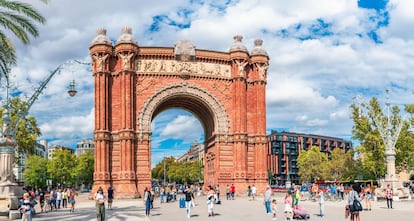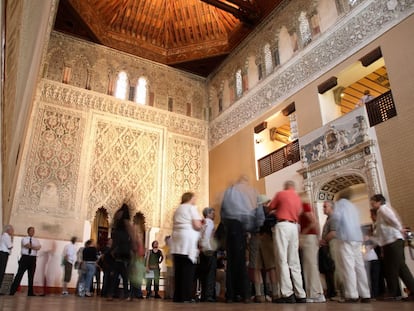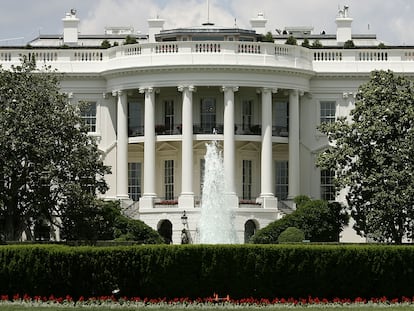Neo-Mudéjar Barcelona, a hidden pearl among modernisms
The tourist that wants to go beyond the official circuit can take a journey through the mid-19th century architecture of the Catalan capital, impregnated by a neo-Arabic air and rich in history

The Spanish city of Barcelona, like every European metropolis, has been very concerned in recent times about creating an official account of its history, easily recognizable throughout the endless urban traces of its streets. However, there is an invisible period in the history of this Catalan capital: the Muslim one, spanning between the years 718 and 801, when the Frankish king Louis the Pious defeated the Arab invader to recover this strategic enclave for Carolingian interests. Destroyed over the centuries, there is no evidence of the presence of the Caliphate of Córdoba in the streets of Barcelona. On the other hand, the second half of the 19th century led to a boom in Neo-Mudéjar architecture for various reasons, the main one being the growth possibilities derived from the demolition of the medieval walls in 1854, when the city obtained the immense plain between its old limit and the nearby villages — which later became known as the Eixample — for its expansion.
This refoundation had to be carefully planned; Ildefons Cerdà, the engineer appointed by Madrid for the task, even set a series of aesthetic guidelines for the Eixample. They were ignored, however, because the new rich who occupied it wanted with all their might to be seen in colorful, exotic homes — both to stand out and to be equated with the French bourgeoisie, which was very absorbed in oriental fashions.
This neo-Mudéjar style arose around the beginning of the 1870s, and, due to economic reasons, it is distributed throughout different parts of the city. There were many buildings with Arabic details in the city center; today one can only admire the Casa Pere Llibre at number 24 of Passeig de Gràcia, which is hardly mentioned in the guides despite being an exception in that engaging avenue. It was built in 1872 by the architect Domènec Balet i Nadal, and it displays a profusion of geometric motifs, polylobed arches, wrought iron railings (a modernist prelude) and large windows with horseshoe arches. Other visible elements are much further away, in the distant periphery of Sant Gervasi, which at that time was a suburb populated by Barcelona lords that wished to have summer villas in the nearby periphery and was finally added to the metropolis on April 20, 1897. A construction popularly known as the German’s house or the Alhambra Building — also by the architect Domènec Balet, as well as the name of its street, del Berlinés (Berliner’s) — has given rise to endless legends. Built in 1875, its amazing façade stands out from the rest of the contemporary urban complex.

The myth of this construction, which is protected by the City Council, derives from its interior, which is inaccessible unless you are very lucky and someone opens the door so you can admire the lobby: a scale copy of the Court of the Lions of the Alhambra in Granada. According to a popular account, a Berlin citizen married a woman from Granada and made that replica of the Andalusian architectural jewel in honor of her love. In reality, the German was called Otto Streitberger. He was a hustler in the business world at the end of the 19th century and was content to give his wife (who was from Cadiz) a villa in the town of Caldes de Malavella. The endurance of this myth is understandable given the few surviving samples in Barcelona of this Islamic inspiration, also theorized by the leaders of the incipient Catalanism — many of them architects — as a way of resuscitating all medieval forms in order to distance themselves from the Renaissance predominance on European land. This would situate this entire trend as a foretaste of modernism, which only materialized in 1891 when a municipal law allowed the façades to be more profusely decorated.
Before that year, the neo-Mudéjar style spread with ease without being branded as eccentric. The edges were filled with some villas bearing these attributes. One of the most peculiar ones is Torre Marsans, at 41 Passeig Mare de Déu del Coll: it deceives at first glance because its entrance resembles a castle, the prelude to a climb up to a 1907 mansion designed by Juli Marial Tey, with a square floor plan and exuberant decorations in its interior patio, an Arabic cloister that dazzles with its polychrome.
If you go down the Vallcarca viaduct from the Torre Marsans, you will be able to observe the idiosyncrasies of this neighborhood, which still exudes an aroma of peace despite its densification during the 20th century. From the bridge it is not difficult to notice a Mozarabic horseshoe arch crowned with two eagles; it is the only vestige of the family residence of Joan Batllori in Vallcarca, an old 19th century estate popularly known as Casa de los Arabescos. It was demolished between 2009 and 2011 as part of an urban reform that concluded in 2017 and which turned the area into a landscaped pathway.
Before that border year, the neo-Mudéjar was deployed with ease without being branded as eccentric. The margins were filled with villas with these attributes. One of the most curious is the Torre Marsans, at 41 Passeig Mare de Déu del Coll. It deceives at first glance because its entrance resembles a castle, the prelude to a climb up to the mansion from 1907, signed by Juli Marial Tey, with a square floor plan and exuberant decorations in its interior patio, a dazzling Arabic cloister due to its polychrome.

If we go down the Vallcarca viaduct from the Torre Marsans, we will be able to observe the idiosyncrasies of this neighborhood, still with an aroma of peace despite its densification during the 20th century. From the bridge it is not difficult to notice a Mozarabic horseshoe arch crowned with two eagles. It is the only reminiscence of the family residence of Joan Batllori in Vallcarca, an old 19th century estate popularly known as the Casa de los Arabescos. It was demolished between 2009 and 2011, within the framework of an urban reform that concluded in 2017 and which turned the axis into a landscaped pathway.
The Casa de les Altures, a building designed in 1890 by Enric Figueras Ribas for the General Water Company of Barcelona, which adopted it as its headquarters, had better luck. Since the 1990s, this neo-Mudéjar pearl has been the seat of the municipal council of the Horta-Guinardó district.

The taste for neo-Mudéjaric architecture declined when the Catalan bourgeoisie found in modernism a unitary form of expression as a symbol of its strength. However, until 1900 there were still some contributions, supported by an official discourse; not in vain the Arc de Triomf designed by the architect José Vilaseca as the main entrance to the Universal Exhibition of Barcelona in 1888 draws from those Moorish airs, as well as the Las Arenas bullring in the Plaça d’Espanya, built at the behest of the businessman José Marsans and which functioned since 1900 as a multipurpose space, hosting political rallies and bullfights until 1977, when its future was uncertain until it was turned into a shopping center and an exceptional viewpoint. It is worth visiting due to its 360-degree panoramic views that show how the surroundings of Montjuïc are the central point of the mix of styles, between the Venetian Towers, towards the mountain, the National Palace in the distance and the Escorxador Park, with its Woman and Bird statue by Joan Miró.
The Catalan capital, like any big city of our time, is an amalgamation of styles. The neo-Mudéjaric designs spread stealthily, and detecting them is a pleasure for the visitor who does not want to settle for the official routes and prefers to stray and find all the hidden Barcelonas among the landmarks of the tourist circuit.
Sign up for our weekly newsletter to get more English-language news coverage from EL PAÍS USA Edition
Tu suscripción se está usando en otro dispositivo
¿Quieres añadir otro usuario a tu suscripción?
Si continúas leyendo en este dispositivo, no se podrá leer en el otro.
FlechaTu suscripción se está usando en otro dispositivo y solo puedes acceder a EL PAÍS desde un dispositivo a la vez.
Si quieres compartir tu cuenta, cambia tu suscripción a la modalidad Premium, así podrás añadir otro usuario. Cada uno accederá con su propia cuenta de email, lo que os permitirá personalizar vuestra experiencia en EL PAÍS.
¿Tienes una suscripción de empresa? Accede aquí para contratar más cuentas.
En el caso de no saber quién está usando tu cuenta, te recomendamos cambiar tu contraseña aquí.
Si decides continuar compartiendo tu cuenta, este mensaje se mostrará en tu dispositivo y en el de la otra persona que está usando tu cuenta de forma indefinida, afectando a tu experiencia de lectura. Puedes consultar aquí los términos y condiciones de la suscripción digital.
More information
Archived In
Últimas noticias
Welcome to the post-religion era: The idea of Christianity as the absolute truth has become obsolete
‘I thought you would like it’: The risky sexual practice popularized by TV shows and TikTok
The digitalization of tourism: ‘They promise experiences and gave us the worst possible one’
Mexican peso defies uncertainty with forecasts of a new period of stability in 2026
Most viewed
- Sinaloa Cartel war is taking its toll on Los Chapitos
- Reinhard Genzel, Nobel laureate in physics: ‘One-minute videos will never give you the truth’
- Oona Chaplin: ‘I told James Cameron that I was living in a treehouse and starting a permaculture project with a friend’
- Why the price of coffee has skyrocketed: from Brazilian plantations to specialty coffee houses
- Silver prices are going crazy: This is what’s fueling the rally










































